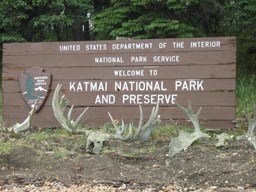Katmai National Park & Preserve, King Salmon Visitor Center
Introduction
Text-to-speech Audio
Images
Katmai National Park and Preserve sign (photo credit: NPS at https://www.nps.gov/katm/planyourvisit/fees.htm)

Backstory and Context
Text-to-speech Audio
King Salmon Visitor Center offers information, exhibits, maps, navigation charts, and videos on Katmai National Park along as other federal public lands on the Alaska Peninsula. Katmai National Park and Preserve is located on a peninsula in southern Alaska. Katmai National Monument was first created in 1918 in order to preserve the famed “Valley of Ten Thousand Smokes”. This valley is a spectacular forty square mile, 100 to 700 foot deep ash flow deposited by Novarupta Volcano. The park was officially designated as a National Park & Preserve in 1980. Today, Katmai remains famous for its volcanoes, but is also popular for brown bears, pristine waterways with abundant fish, remote wilderness, rugged coastline, broad green glacial hewn valleys, active glaciers, and Naknek Lake.
Various residents of communities around the park and preserve have hunted, fished and gathered berries and other materials from the land for numerous generations. Before the 1912 Mt. Katmai-Novarupta eruption, there was four year-round villages along with many other seasonally used camps in what is now called Katmai National Park and Preserve. Due to the heavy ash fall caused by the 1912 eruption, the inhabitants of Savonoski, Kaguyak or “Douglas”, Kukak, and Katmai villages left and resettled elsewhere along the Alaska Peninsula.
Individuals with historic ties to Katmai, typically of Alutiiq descent, now live around southwest Alaska and beyond. Locations especially include the villages of South Naknek, Naknek, King Salmon, Kokhanok, Igiugig, Levelock, Egegik, Chignik and Perryville. Numerous Katmai descendants are actively involved in subsistence activities and participate in the park management process through Alaska Native corporate and non-profit organizations. Katmai National Park and Preserve in Alaska is home to remarkable and distinctive volcanoes and many wildlife including fish, flowers, and bears.
Sources
NPS. 2015. Cultures - Katmai. Website. https://www.nps.gov/katm/learn/historyculture/cultures.htm
